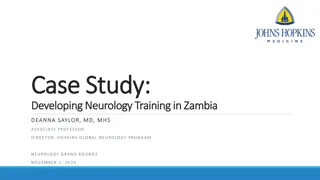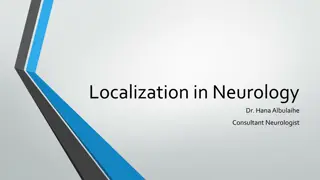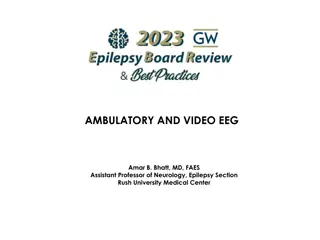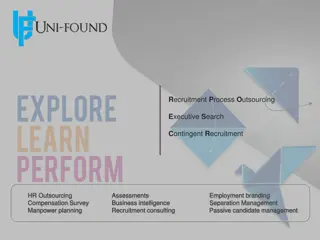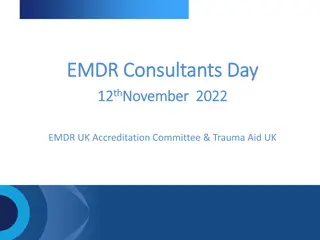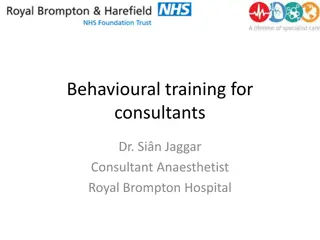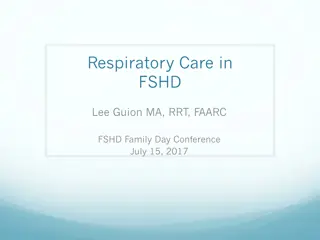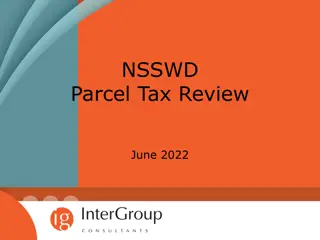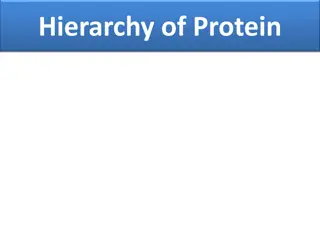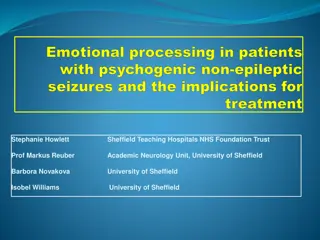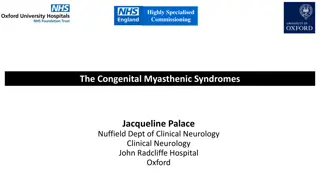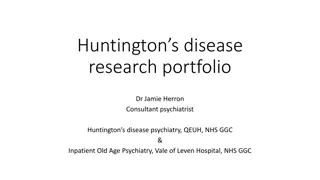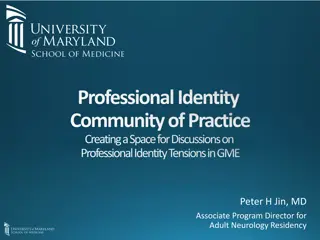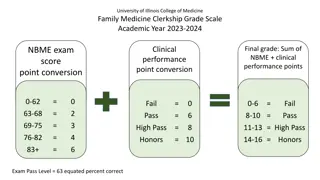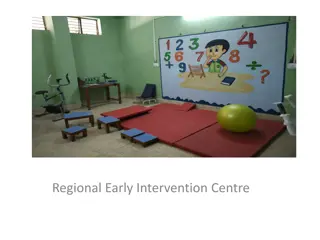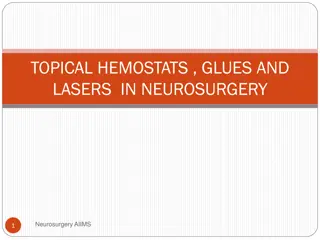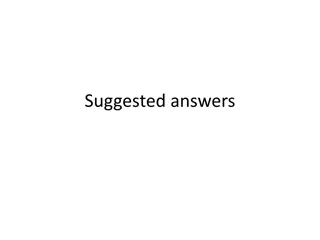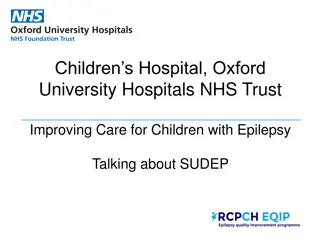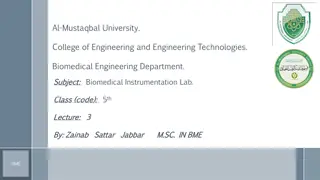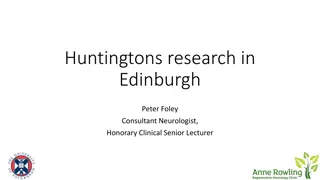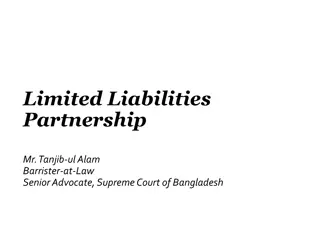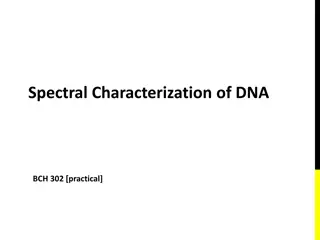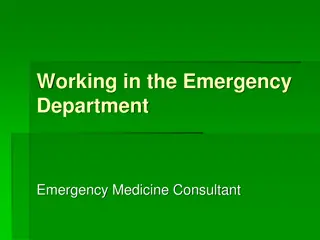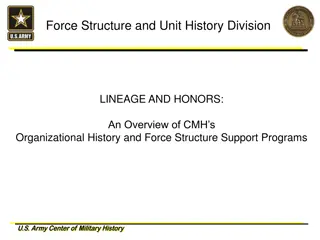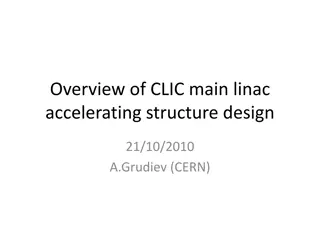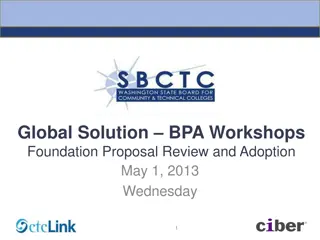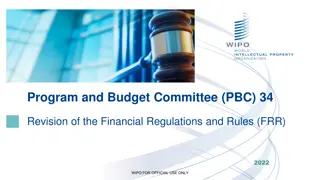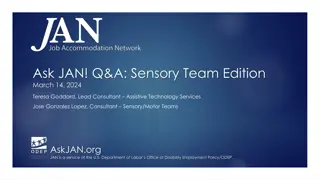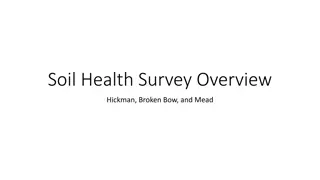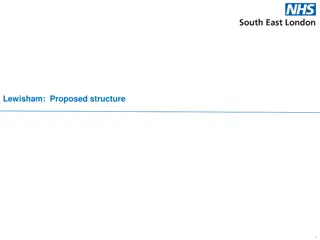Neurology Consultants Service Structure Overview
Introduction to the consultants in neurology, detailing their backgrounds and specialties. Explains the service structure, subspecialties/divisions within the service, coverage schedules, and contact information for different neurology teams. Highlights the separate team for pediatric neurology and the approach to other neuro subspecialties.
Download Presentation

Please find below an Image/Link to download the presentation.
The content on the website is provided AS IS for your information and personal use only. It may not be sold, licensed, or shared on other websites without obtaining consent from the author. Download presentation by click this link. If you encounter any issues during the download, it is possible that the publisher has removed the file from their server.
E N D
Presentation Transcript
Meet the Consultants Neurology
Introduction Consultant(s) background(s) Dr Chris Traner PGY4 + Neurology Chief Resident, Education Staying at Yale for Epilepsy Fellowship Dr John Picard PGY4 + Neurology Chief Resident, Education Staying at Yale for Neurocritical Care Fellowship 2
Service Structure Subspecialties and/or divisions within the service YNHH split teams during the day to cover inpatient vs ED consults, single resident covering for nights and weekends General Adult Neurology: 24/7 in-house coverage Pager: 203-370-5298 Days: Senior resident listed on Amion Nights: Consult resident listed on Amion ED: Logged into dynamic role on MHB Neuro-oncology: M F 8:30-5 only Pager: 203-370-3609 Exception to above: Patients physically located in the YNHH SICU are covered by the Neuro ICU fellow (listed on Amion) 3
Service Structure Pediatric Neurology Covered by a separate team during weekdays M-F 7-5:30 Resident on call listed on Amion Covers both inpatient and ED pediatric consults Nights Consult resident covers both pediatric and adult consults Weekends Contact the resident listed on Amion for new consults Contact the attending for questions on old consults 4
Service Structure Subspecialties and/or divisions within the service Everywhere else General Neurology only, single team structure Locations SRC M-F 9-5: Resident listed in Amion Nights/weekends: Attending listed in Amion NO RESIDENT COVERAGE VA: 24/7 coverage Pager: 203-784-1222 Note that we are on home call on nights and weekends for the VA 5
What about the other Neuro Subspecialties? Contact the general neurology consult service first There are subspecialty fellows listed on Amion, but for the most part all consults other than neuro-onc should go through the consult service. We will be happy to help put you in contact with the subspecialists as appropriate 6
What about procedures? EEG Neurology does not need to be consulted to order an EEG That being said, consult service should be aware of any patient that a continuous EEG is ordered on, particularly as it is the consult resident who checks on EEGs overnight (not the epilepsy fellow) Please note that EEG is not available overnight or on weekends at the VA EMG Rarely indicated inpatient. Neurology consult service should be aware of any patient that this is being ordered on to determine if it is appropriate While an Epic order technically exists for this, it will not happen without the Neurology team being contacted 7
What about procedures? Lumbar punctures As a department policy, we do not perform lumbar punctures on patients not admitted to one of our primary services for patient safety reasons I m not signed off on LPs, what should I do? Weekdays: Contact the hospital procedure team (Will Cushing) Nights/weekends: Reach out to the MICU 8
Service Flow How do I place a consult? YNHH/SRC Epic order Please include a phone number that we can reach you at! VA call pager (203-784-1222) Not sure you need a formal consult? YNHH: page 370-5298 or text resident on MHB SRC: text resident on MHB What s the best time of day to place consults? Late morning/early afternoon preferred Non-urgent consults should ideally be minimized overnight or on weekends 9
Service Flow When should teams expect to hear back and/or see notes in Epic? We try our best to return all pages/texts/new consult requests within 15-20 minutes Note that this may be a touch longer on nights/weekends if the consult resident is involved in an emergency All consults are seen and staffed by an attending within 24 hours 10
Stroke Codes When should a stroke code be called? Acute onset of a focal neurologic deficit Patient last known normal within 24 hours What is a focal neurologic deficit? FAST face, arm, speech, time Aphasia: inability to speak and/or inability to follow commands Unilateral weakness Unilateral numbness 11
Stroke Codes Ok, I called a stroke code. Now what? VA nights/weekends: page/call neurology SRC: nights/weekends covered by tele-stroke attending YNHH: we are on our way. No need to call/place an Epic consult order What information should I be looking up while I m waiting for neurology (at YNHH)? Last known normal Medication list notably if patient on anticoagulation, and if so, when was their last dose (NOACs) or last INR Last set of labs glucose, platelets, coags 12
Stroke Codes Help! I m at the VA/SRC overnight/on a weekend and neurology isn t in house! FIRST: perform a NIHSS stroke scale Available in MedCalc and IV Stroke Thrombolysis apps All crash carts have a set of stroke cards (the pink ones) attached for you to use The neurology resident (VA) or the tele-stroke attending (SRC) will help you with next steps based on the story and presentation 13
Stroke Codes 14
Stroke Codes When shouldn t I call a stroke code? Altered mental status (AMS) without any evidence of focal deficits on exam Bilateral weakness or numbness w/o change in LOC CT/MRI brain shows evidence of an acute/subacute/chronic stroke with patient s last known normal >24 hours ago or patient asymptomatic Seizure Desire for urgent neuro consult 15
Seizures Help! My patient is having a seizure! Remember your ABCs O2, turn patient on side, move objects away from patient Do not attempt to hold down patient or place anything in patient s mouth Give Ativan IV 2-4 mg IV at 2-3 minute mark If patient has stopped seizing by time Ativan is drawn up and ready to give, do not give May repeat Ativan dose x1 if patient still seizing after an additional 5 minutes Check a full set of labs, including a fingerstick glucose Page/call neurology 16
Seizures Things we may ask you: How long did the seizure-activity last? What did the patient look like during the seizure? Eyes deviated to one side or the other? Head turned? Any evidence of tongue bite? Urinary/bowel incontinence? Was the patient post-ictal after event? If so, how long did that last? Any recent medication changes? 18
Seizures AEDs = antiepileptics We will help you figure out if your patient needs AEDs That being said, if for some reason you can t get in touch with us, keppra 40-60 mg/kg (max 4.5 g) IV is a very good initial AED choice If your patient was on/supposed to be on AEDs prior to seizure, PLEASE send all levels prior to loading with an AED 19
Antiepileptics (AEDs) Never hold a patient s antiepileptics Getting surgery? Make sure NPO order says ok for meds No enteral access? Talk to pharmacy and/or us Do not adjust patient s antiepileptics without touching base with us (hint: this is a great curbside question!) AED levels are guidelines. Some of our patients live happily at subtherapeutic levels, and some we want at consistently supratherapeutic levels We love when primary teams check levels. That being said, please call us before you change the patient s medications Medications to avoid in patients with seizures: Tramadol/Ultram Wellbutrin/bupropion Ciprofloxacin 20
Antiepileptics Patient w/o enteral access Never hold a patient s antiepileptics Speak to pharmacy and/or curbside us for help converting PO meds to IV There are several AEDs that do not have an IV equivalent Examples: oxcarbazepine/carbamazepine, onfi, lamotrigine Call us and we will help review the patient s chart and see if we need to formally follow (for complicated patients) or if there is no option but to place an NG/NJ tube 21
Seizures Special Circumstances Alcohol withdrawal seizure Treat the alcohol withdrawal There is no role for AEDs, cEEG or a neurology consult Seizure due to severe metabolic derangements Hypo/hyperglycemia, severe hypocalcemia, hypomagnesia, hyponatremia No role for AEDs. Treatment is fixing underlying condition PNES (formally diagnosed, not suspected) Do not treat seizures with Ativan/benzos/AEDs Call psych/BIT team for assistance with management 22
PNES/Conversion Disorder What is PNES? Psychogenic non-epileptic spells/seizures Diagnosed with continuous EEG monitoring spells/events captured without evidence of a correlate on EEG Treated with cognitive behavioral therapy Conversion disorders With the exception of PNES, no definitive neurologic test exists to confirm a diagnosis of conversion disorder Diagnosis based on clinical suspicion/diagnosis of exclusion 23
Conversion Disorder How should I think about a patient that I suspect has conversion disorder? Does the problem localize? I.e. Is there somewhere along the neuro-axis that could cause these symptoms? Does my exam fit with what the patient is telling me? Give-way weakness Hoover sign Patient unable to lift legs from bed, but is able to walk Does the presentation make sense? How is my patient acting about their symptoms? La belle indifference Remember, conversion disorder malingering 24
Altered Mental Status (AMS) #1 cause of AMS in hospitalized patients? 25
Altered Mental Status (AMS) #1 cause of AMS in hospitalized patients? DELIRIUM #2 cause? 26
Altered Mental Status (AMS) #1 cause of AMS in hospitalized patients? Delirium #2 cause? Toxic metabolic causes 27
Altered Mental Status Delirium Who is at risk? Patients with pre-existing cognitive impairment Age >80 y/o Male gender Prolonged hospitalization Notably if patient was in an ICU setting at some point during their hospitalization Admitted with an active infection Hx of EtOH/substance abuse Sedative/narcotic use 28
Altered Mental Status Delirium Characteristics Waxing/waning mental status Reversal of sleep-wake cycle May be hypoactive or hyperactive Treatment delirium precautions! Maintaining normal sleep-wake cycles Minimizing care/disruptions over night Keeping windows open during the day Frequent re-orientation Minimizing use of sedatives/narcotics/neuroleptics Benzodiazepines are almost never the right choice in treating delirium!!! 29
Altered Mental Status Delirium Remember that a ounce of prevention is worth a pound of treatment! Melatonin Critical look at orders requiring care overnight 30
Altered Mental Status Toxic metabolic causes Metabolic derangements Hypo/hyperglycemia Hypo/hypernatremia Hypercalcemia Hypercarbia/hypoxemia Hypotension EtOH intoxication/withdrawal Benzo/opiate intoxication/withdrawal Infections Fever/sepsis UTI AMS/delirium is considered a symptom of a urinary tract infection Other Hyperammonemia Low thiamine levels (Wernicke s encephalopathy) Low vitamin B12 levels 31
Altered Mental Status Need for Neurology Consult Toxic metabolic causes and delirium considered and felt to be inadequate to explain patient s presentation/degree of AMS What work-up should be done prior to calling neurology? Look at patient s medication list anything that can be cleaned up that may be contributing? TSH/T4, CMP, Ca/Mg/Phos, ammonia, vitamin B12, thiamine level UA/infectious w/u, ABG in appropriate patients 32
Altered Mental Status Need for Neurology Consult What information should I have when I call neurology? Baseline cognitive status Description of current mental status Results of above basic serum w/u Should I order imaging before I call neurology? No (In the absence of focal neurological deficits) Often negative/non-contributory MRI in particular often difficult for altered patients to tolerate, requiring sedation/neuroleptic medications to obtain worsening delirium We will help you decide if further neuroimaging is indicated on a case-by-case basis 33
Migraines/HA Migraines: moderate to severe unilateral or bilateral headache, throbbing vs pressure-like in quality, accompanied by photophobia +/- phonophobia +/- nausea/vomiting +/- aura Red flags on history Acute onset worst headache of life Worse with lying down or Valsalva maneuver New onset headaches after the age of 50 Red flags on exam Decreased LOC Fever Papilledema Focal neurologic deficit 34
Migraines/HA 2SNOOP4 = acronym for secondary causes of headaches Systemic disease cancer, chemo tx (PRES) HIV/immunocompromised Systemic signs fever, weight loss Neurological deficits beyond aura LOC, seizures, focal deficit Onset <2 min - thunderclap HA, SAH Older onset of headaches after age 50 Papilledema Positional Worse w/ lying down = ICP (concern for mass lesion vs hydrocephalus) Worse w/ standing up = ICP (concern for post-LP/low pressure HA) Prior HA different Precipitants notably if HA only occurs w/ severe coughing or sexual activity 35
Migraines/HA Inpatient consult Red flag signs/symptoms Exceptions: Post-LP headaches in patients not tapped by neurology generally managed by pain service Clear bacterial meningitis Outpatient referral Failed trial of first line triptan (sumatriptan 50-100 mg) Minimum 4 headache days a month 36
Migraines/HA Does my headache patient need brain imaging? 37
Migraines/HA Does my headache patient need brain imaging? Answer is usually no Part of the Choosing Wisely campaign is dedicated to reducing the use of brain imaging in migraine When does a headache patient need imaging? Red flag signs/symptoms Onset after age 50 Complicated migraines Migraines associated with focal neurologic deficits Headaches that consistently occur after exercise or sexual activity 38
Migraines Abortive treatment algorithm Outpatient PO regimen: sumatriptan 50-100 mg + reglan 10 mg + NSAIDs Inpatient IV regimen: Toradol 15-30 mg IV + reglan 10 mg IV + mag sulfate 2 g IV + NS 500-1000 cc +/- Benadryl 25-50 mg PO/IV Repeat q6 hrs Second line: Depakote 500 mg IV Note: check urine pregnancy on women of child bearing age prior to administration Third line: DHE Neurology should be consulted at this point Medrol dose pack or solumedrol 250-500 mg IV inpatient can reduce the risk of migraine recurrence 39
Migraines What drugs should I avoid in migraine patients? Fioricet or other butalbital containing medications Opiates Reglan/compazine outperformed dilaudid for tx of acute HA Griffin JD, Mycyk MB, Kyriacou DN. Metoclopramide versus hydromorphone for the emergency department treatment of migraine headache. J Pain. 2008;9(1):88-94 Friedman BW, et al. Randomized study of IV prochlorperazine plusdiphenhydramine vs IV hydromorphone for migraine. Neurology. 2017;89(20): 2075-2082 Can be considered in patients w/ subdural hematomas/recent post-op patients, however considered treatment of last resort 40
Vertigo/Dizziness Approach to patient Characterize the symptoms Lightheadness/near syncope? Check orthostatics Feeling of dysequilibrium? Usually due to sensorimotor impairment think peripheral neuropathy vs cerebellar pathology Check finger to nose for evidence of dysmetria, watch patient walk True vertigo Sensation of room/head spinning, often accompanied by diplopia and nausea 41
Vertigo/Dizziness Vertigo Symptom Peripheral Central Nausea/vomiting Imbalance Severe Mild-moderate Pts can walk, though may be uncomfortable Common Rare 1. Unidirectional 2. Inhibited by fixation 3. Fatigable Mild to moderate Severe Pts cannot walk without falling Rare Common 1. Direction-changing or rotary 2. Not inhibited by fixation 3. Persistent Negative or equivocal Hearing loss/Tinnitus Other neuro deficits Nystagmus HiNTS Exam Positive 42
Vertigo/Dizziness HiNTS Exam Highly specific and sensitive for differentiating central vs peripheral causes of vertigo in symptomatic patients Sensitivity>96%, specificity between 85-96% depending on study cited More sensitive than an MRI in acute posterior fossa strokes and you can do it at bedside! 43
Vertigo/Dizziness HiNTS Exam Hi = head impulse test Rapid head rotation by examiner w/ pt s gaze fixed on examiner s nose Peripheral vertigo eyes deviate away from examiner s nose when turning head TOWARDS side of the lesion, with corrective saccades back to midline N = nystagmus Peripheral unilateral nystagmus w/ slow phase TOWARDS side of lesion Central direction changing or rotary nystagmus TS = test of skew 44
Vertigo/Dizziness HiNTS Exam TS = test of skew Alternate eye cover testing Central vertical misalignment of eyes on testing Youtube videos https://www.youtube.com/watch?v=VwmrjYuvqtQ 45
Vertigo/Dizziness HiNTS Exam I think my patient has a peripheral cause of their vertigo now what? Treat symptomatically w/ meclizine Vestibular neuritis treat w/ a 3 wk steroid taper, starting at 100 mg qday BPPV Epley maneuver +/- referral for vestibular therapy Meniere s disease low salt diet +/- Dimax I think my patient has a central cause of their vertigo or I performed the HiNTS exam and I m not sure Consult neurology 46
Vertigo/Dizziness Vertigo Concern for Central Cause What is neurology going to ask me? Description of symptoms, including timing of onset (acute vs gradual) Can the patient walk? Patients with a peripheral cause of vertigo are often reluctant to walk because it makes them feel nauseous, however it is incredibly important to see if they can walk! Please walk all patients (with precautions) before you call neurology Results of HiNTS exam +/- Dix - Hallpike maneuver 47
Cardiac Arrest Patients Or, why won t neurology give my patient s family a clear answer about long-term prognosis? 48
Cardiac Arrest Patients Short answer: we usually can t Neuroprognostication after cardiac arrest notoriously difficult, with repeated studies showing mixed/contradicting results Yale is part of an international research consortium attempting to come up with better ways to answer this question Poor prognostic factors: Myoclonic status epilepticus confirmed on EEG Note: does not apply to patients with myoclonus on exam w/o an EEG correlate, who can survive (Lance-Adams syndrome) Absent N20 on SSEPs completed >72 hrs from euthermia Complete/near complete loss of gray-white matter differentiation on MRI brain completed >72 hrs from euthermia 49
Curbside Question List What doesn t require a formal consult? Converting AEDs (anti-epileptics) from PO to IV First time seizure back to baseline Patient known to an outpatient Yale neurologist, needs closer outpatient f/u How do teams reach you in these instances? YNHH/SRC: text resident listed in Amion on MHB VA: Page 203-784-1222 50


